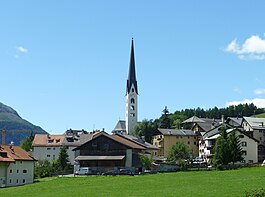Zuoz
| Zuoz | ||
|---|---|---|
 |
||
|
||
| Coordinates: 46°36′N 9°58′E / 46.600°N 9.967°ECoordinates: 46°36′N 9°58′E / 46.600°N 9.967°E | ||
| Country | Switzerland | |
| Canton | Graubünden | |
| District | Maloja | |
| Area | ||
| • Total | 65.79 km2 (25.40 sq mi) | |
| Elevation | 1,716 m (5,630 ft) | |
| Population (Dec 2015) | ||
| • Total | 1,250 | |
| • Density | 19/km2 (49/sq mi) | |
| Postal code | 7524 | |
| SFOS number | 3791 | |
| Surrounded by | Bergün/Bravuogn, La Punt-Chamues-ch, Livigno (IT-SO), Madulain, Pontresina, S-chanf | |
| Website |
www SFSO statistics |
|
Zuoz (![]() [tsuə̯ts] ) is a municipality in the Maloja Region in the Swiss canton of Graubünden.
[tsuə̯ts] ) is a municipality in the Maloja Region in the Swiss canton of Graubünden.
Zuoz is first mentioned about 840 as Zuzes. Historically, Zuoz was the political center of the upper Engadin. It was the seat of the local bishop. But, it has long ago been supplanted by other Engadin villages such as St. Moritz and Samedan.
In 1137-39 the village was acquired from the count von Gamertingen by the Bishop of Chur. In 1244 Bishop Volkart appointed Andreas Planta from Zuoz to be the chancellor of the Oberengadin. The Planta family remained in power until 1798. In 1367, Zuoz joined the League of God's House under the leadership of the Amtmann Thomas Planta.
The continuing arguments between Zuoz and Samedan led, in 1438, to the division of the court into two parts, the courts of Sur and Suot Funtauna Merla. In 1492, the village bought the Bishop's property and rights to tax in Zuoz. Then, in 1526 the Bishop lost the right to high justice with the Ilanzer articles. In the Swabian War the inhabitants ignited their fields to force the enemy to retreat. Over the course of the 15th Century, several villages became independent of Zuoz. S-chanf left in 1518, La Punt-Chamues-ch in 1528 and Madulain in 1534. In 1554, Zuoz joined the Protestant Reformation and converted.
...
Wikipedia




